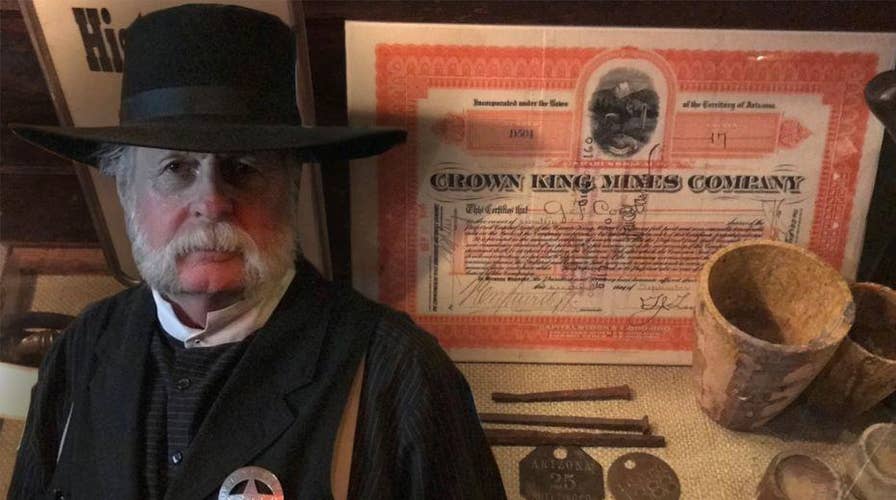Historic saloon brings visitors back to old frontier
Arizona saloon has original artifacts from late 1800’s, including bar, cowboy pistols, and mining equipment.
So, a guy walks into a bar –and in this case, stumbles upon not just any bar—an historic western saloon on the old frontier with original artifacts displayed throughout.
The Palace Restaurant and Saloon is on historic Whiskey Row in Prescott, Arizona. It's on the National Register of Historic Places, listed as established in 1877.
“This could just be another bar, but it’s not just a bar—it’s a saloon,” Ray Saulnier, a regular at the saloon, said. “It’s the most historic saloon here.”
Dave Michelson bought the bar in 1996 to restore it to its original look, calling it “the most iconic building the state.”
"You look at that back bar and you think you’re actually in the old west…cowboys came here, miners came here."
“It’s just a classic,” Michelson, the restaurant and saloon’s owner said (while sporting a cowboy hat). “You look at that back bar and you think you’re actually in the old west…it’s the oldest saloon in the state…cowboys came here. Miners came here.”
PIRATE MYSTERY: DOES THIS 300-YEAR-OLD BONE BELONG TO 'BLACK SAM' BELLAMY?
“It’s a step back in time,” Saulnier said.

The original bar is still in use and was rescued from a fire that destroyed the building in 1900 (Fox News)
A step into the building takes visitors back to the ‘wild, wild west’ during the American frontier days.
“Virgil Earp was the constable back before his brothers got here—Wyatt and Morgan—and he actually killed a cowboy out in front of the Palace,” Michelson said. “Doc Holiday (played) cards here before they went to Tombstone.”
There are seven showcases of antiques and artifacts on display throughout the saloon, which is now a full restaurant and bar.
“The front and back bar—it’s iconic, it’s original, and it tells a story,” Danny Romero, a Palace regular (also sporting a cowboy hat) said.
THE LAST AMERICAN SLAVE SHIP MAY HAVE BEEN DISCOVERED
Michelson says the original bar is still in use and was rescued from a fire that destroyed the building in 1900: “They knew they couldn’t save the building, so the place was packed, of course, on a Saturday night with cowboys, miners, ladies of the night, and they actually carried the bar out, dragged the bar out across the street,” Michelson said. “They got some oxen up front and actually dragged it across the street and kept on serving while the Palace was burning to the ground.”
Other displays include artifacts from the late 1800s to early 1900s: artifacts from the Indian Wars, cowboy pistols and bullet holes in the tin roof, mining equipment, and gambling artifacts that were used on Whiskey Row and at the saloon.
“It doesn’t necessarily mean that they were all heroes or villains, but it’s history. That’s what we’re trying to preserve—history."
While guests are served food and drinks, they can also get a slice of history while visiting.
“The west is our culture—that’s what I think people think of the United States when they’re not here,” Michelson said. “They see westerns. They think of the west as our main culture.”
“It doesn’t necessarily mean that they were all heroes or villains, but it’s history,” Saulnier said. “That’s what we’re trying to preserve—history."
STOLEN FLINTLOCK RIFLE THAT WAS USED AT BATTLE OF NEW ORLEANS RETURNED TO MUSEUM
“If you forget where you came from, you don’t know where you’re going," Stephen F. Waller, another regular at the saloon, said. Waller went on to say: “There wasn’t a Wal-Mart on every corner back then. If you wanted something, you had to find it, or make it, or do it yourself. I think that’s so much that we’ve lost.”
"When people say ‘Why are you dressed up?’ I’m not. This is the way I dress. To me, that’s perfectly normal."
“It’s the gem of Arizona,” Romero said. “Everything you see is the way it was when they opened it in (1901). So, it’s a special place filled with special people.”
Staff and regulars at the saloon dress in period attire from the Western days.
“All the faculty, all the staff—they’re educated in what this place has been and what it is,” Romero said. “So that anybody that walks through (those) swinging doors, can learn rather quickly about where they are.”
Waller dresses in period attire from the 1870’s with an 1873 pistol and 1867 pocket watch.
“I haven’t worn jeans or sneakers … this is me,” Waller said. “This is what I do. I’m like this seven days a week. So, for me, when people say ‘Why are you dressed up?’ I’m not. This is the way I dress. To me, that’s perfectly normal."
“This is the place to work,” Andrea Swint, a recent hire at the saloon, said.
A place or in their eyes, a palace, in the form of a saloon.

